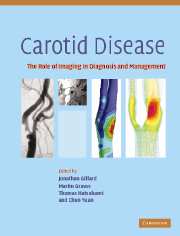Book contents
- Frontmatter
- Contents
- List of contributors
- List of abbreviations
- Introduction
- Background
- Luminal imaging techniques
- Morphological plaque imaging
- 14 MR plaque imaging
- 15 CT plaque imaging
- 16 Assessment of carotid plaque with conventional ultrasound
- 17 Assessment of carotid plaque with intravascular ultrasound
- 18 Image postprocessing
- Functional plaque imaging
- Plaque modelling
- Monitoring the local and distal effects of carotid interventions
- Monitoring pharmaceutical interventions
- Future directions in carotid plaque imaging
- Index
- References
16 - Assessment of carotid plaque with conventional ultrasound
from Morphological plaque imaging
Published online by Cambridge University Press: 03 December 2009
- Frontmatter
- Contents
- List of contributors
- List of abbreviations
- Introduction
- Background
- Luminal imaging techniques
- Morphological plaque imaging
- 14 MR plaque imaging
- 15 CT plaque imaging
- 16 Assessment of carotid plaque with conventional ultrasound
- 17 Assessment of carotid plaque with intravascular ultrasound
- 18 Image postprocessing
- Functional plaque imaging
- Plaque modelling
- Monitoring the local and distal effects of carotid interventions
- Monitoring pharmaceutical interventions
- Future directions in carotid plaque imaging
- Index
- References
Summary
Introduction
Over three decades ago continuous-wave (CW) Doppler was introduced as the first ultrasound (US) investigation for evaluation of carotid stenosis. Since that time, the rapid development of noninvasive US techniques has resulted in a wide variety of clinical applications for assessment of carotid disease. This chapter will discuss the clinical merits and limitations of US techniques for evaluation of both early and advanced carotid disease. It will then address recent developments including carotid plaque perfusion and molecular imaging of carotid disease.
Ultrasound techniques for evaluation of carotid disease
Doppler sonography
US Doppler techniques are commonly used for examining the carotid arteries. Interpretation of Doppler signals is based on analysis of the audio signals and of the frequency spectrum. The Doppler effect is named after Christian Doppler, who described the effect of moving objects on the change in frequency of emitted light in 1842. This effect is familiar to anyone who has stood in one place and listened to a source of sound passing by. The rising pitch of the passing movement of sound rushes toward the listener and equally drops as the source leaves him behind. Similarly, the Doppler frequency shift, which is the difference between emitted and received US frequency, is proportional to the velocity of moving blood cells.
CW Doppler systems use two transducers, one of which emits while the other receives US continuously.
Keywords
- Type
- Chapter
- Information
- Carotid DiseaseThe Role of Imaging in Diagnosis and Management, pp. 208 - 222Publisher: Cambridge University PressPrint publication year: 2006

